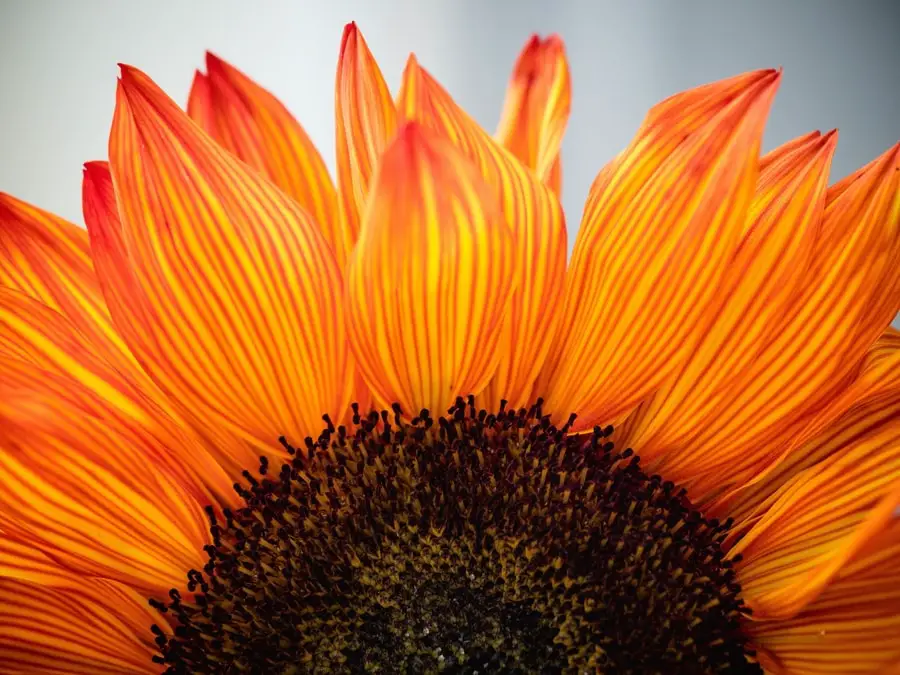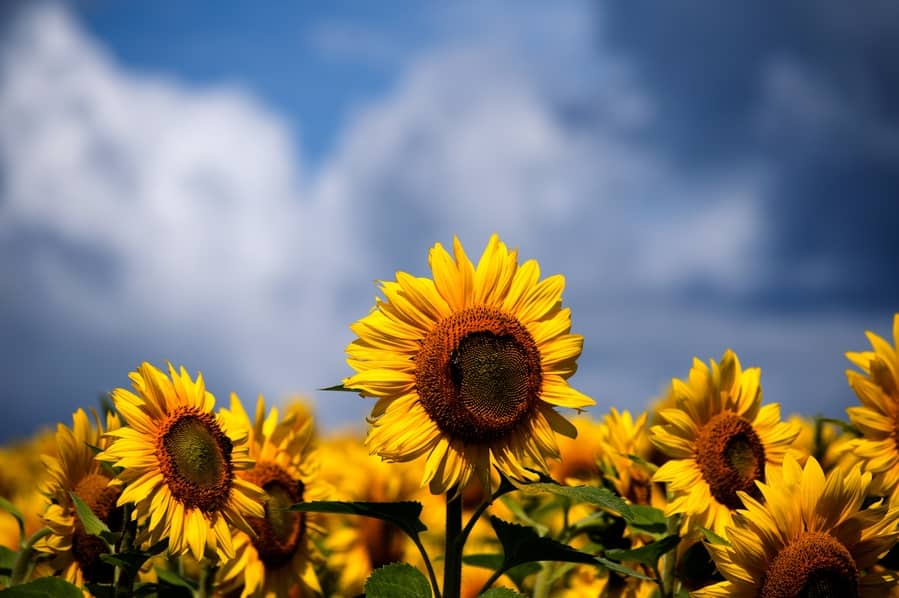I just had to write about this as my first topic. It’s one of my all-time favorite things about sunflowers, and so many people ask the question that it deserves a proper answer. I hope I can help, and offer some detail around the behavior of Sunflowers whilst I’m at it!
So, do sunflowers follow the sun? The answer is yes, they do. They have an inbuilt mechanism which has evolved over thousands of generations of sunflowers in order to take full advantage of natural light for photosynthesis. There are also other reasons why sunflowers follow the sun too. Let’s explore them in more detail.
The Wonders of Mother Nature
This is a fascinating question, and to me is one of the wonders of mother nature entirely – not just sunflowers!
The sunflower does indeed follow the sun. The green flower bud, blossom stem, always face East for the early morning sun, and gently throughout the day they track the sun across the sky, finally facing the west for the last of the sun’s warmth – in the afternoon and early evening.
Then, overnight, and just as wonderfully, they return to their original starting position. Facing east for the next days rising sun to start the process again.
How Do Sunflowers Follow The Sun?
Now that we know that sunflowers do follow the sun, let us go into a few more details about how and why this happens.
Photosynthesis
Photosynthesis is one of the reasons why following the sun happens, actually it’s one of the main reasons why this happens so let’s first understand what photosynthesis is.
Photosynthesis happens in the green part of the plant. It is the plant converting sunlight into chemicals creating a growth hormone called auxins.
Auxins or growth hormone, regulate what speed and what length the plant cells grow.

This happens in our sunflowers leaves, flower bud and usually at the top of the stem behind the flower bud. In its young growing stage, it happens rapidly before the flower opens and is fully bloomed.
Through photosynthesis, the cells in most other plants grow at the same speed, and length.
…not so in the world of the sunflowers.
And this is where the fascinating phenomenon of sunflowers following the sun comes into play.
This is called heliotropism, which basically means that a plant will grow in the direction the sun shines. It’s also known as solar tracking.
This Is Called Heliotropism
The ancient Greeks already knew that certain plants followed the sun and named one of those plants heliotropism.
Helio: meaning sun
Tropism: meaning turn
Thus: Sun-turn.
So to say a plant does heliotropism basically means it will turn towards the sun and will grow in the direction from which the sun shines. It is also known as ‘Sun tracking‘ or ‘Solar Tracking’.
How Heliotropism, or Solar Tracking Works
Most living organisms have a 24-hour biological clock, in plants, it is called Circadian rhythm.
This 24-hour clock tells the cells in living things when to wake up and when to sleep.
In plants, the circadian rhythm tells their cells when to grow and at what rate to grow. It’s also the same mechanism that instructs flowers to open in the morning and close in the evening. It has many of the same effects on humans
In the morning, as the green flower bud faces east, the cells in the bud and stem are growing. But in sunflowers the cells that are on the shady side of the stem grow longer. As the sun moves across the sky the shaded area on the stem moves too.
By the next morning, as the flower bud faces East, the cells on the shady side of stem, behind the bud head, are ‘conditioned’ to grow longer and quicker. As the sun moves across the sky the shaded area of the stem moves too. The cells are told to ‘stop’ growing on the now sunnier area and to start growing on the newly shaded part of the stem.
This acts like a spring coil and rhythmically allows the sunflower bud to follow the sun. Below is the process of Heliotropism in illustrated form

As the sun goes down in the west, the sunflower stem becomes shaded and the cells instruct the shaded east side of the stem to begin expanding again. This carries on during the night and by morning sunrise the flower bud is again facing the east and starts tracking the sun across the sky once again for the new day.
Why Do They Follow the Sun?
Whereas many plants have multiple blooms, the sunflower usually has one bloom on top of one stem. This is a disadvantage as regards to the ultimate goal of seed production.
But the sunflowers evolution has given itself the advantage of following the sun and giving itself the best possibility to convert as much sunlight throughout the day into energy for growth.
The sunflower, bud/young bloom are still at their growing stage. And to become stronger, bigger and healthier it needs to gather as much energy from the sun as it can. So following the sun across the daily skyline gives it this big advantage.
How Long Does Heliotropism Go on For
This daily process of tracking the sun only goes on as long as the sunflower is in the bud and young flower head stage.
Once the fully petaled flower has emerged the heliotropism or, following the sun, stops working.
This is because the blooms are usually so big that the weight of the large flower head can not move to follow the sun.
Once the heliotropism has stopped working. The large sunflower head stations itself by facing East all the time and can now focus all its attention on growing as big a bloom as it can to attract pollinators.
Benefits of Following the Sun
By following the sun on a daily basis from east to west, the sunflower plant and bud have served to nourish itself by converting the sun’s energy into chemicals that have made the overall plant big, strong and healthy enough to support the large flower head when it opens.
After the process of following the sun has finished, and with the flower head facing east it can now concentrate on becoming as big and attractive as it can for its pollinators, such as insects and bees.
By permanently facing the east, the morning sun warms up the flower head and becomes not only stronger and bigger but the warmth attracts its pollinators too.
Which brings us on to the sunflowers main reason for following the sun. Its ultimate goal of seed production. By pollination.
Pollination
Pollination: the transfer of pollen from one flower to another flower.

In doing so, fertilisation occurs and seeds are produced.
Pollination is important for the sunflower to produce an abundance of seeds and is usually carried out by bees.
Having only one flower head, per stem, it is the aim of that flower to be as big and vibrant as it can be.And this was achieved by heliotropism.
Because it followed the sun it gained all the energy for growth in any one given day, and when heliotropism finished the flower head stayed facing the east.
Discover the 31 Most Wonderful Sunflowers – with Images
Where in the Sunflower the Bees like to Be
Within the brightly coloured petals of our sunflower is the large brown center disc. This disc contains lots of smaller flowers called florets.
These florets are laden with pollen and nectar. The bees love the warmed-up nectar, its like their energy drink!
Going into the floret to drink the nectar the bee brushes up against the pollen. Their furry bodies then gets covered in pollen.
The pollen covered bees then fly to the next flower, transferring the pollen from one flower to another. This activates fertilisation.
Pollination and then fertilisation is the process of seed making. And that is our sunflowers ultimate goal.
Although bees are the main Pollinators in sunflowers, it isn’t the only way the flowers pollinate. This in itself is a fascinating area and I’ve written about more about the various ways of pollination here.
And This Is Why It Stays Facing East
The large, weighty flower head makes it harder to follow the sun across the sky. And once again the sunflower has sought an advantage from a weakness,
By stationing the flower head facing east the rays from the early mornings’ sun carry on nourishing the now opening bloom.
The enchanting flower head fully opens and is as big and vibrantly colored as it can be.

The easterly morning warmth of the sun gives it the advantage of being one of the first blooms of the day to gather that warmth. This heat attracts the chilly morning bees and gives the sunflower the biggest opportunity for the early visiting pollinators to stay longer.
Within the brightly colored petals, is the center disc. This disc contains lots of pollen loaded tubular shaped flowers, these are filled with the nectar that the bees love to drink and thrive on. In turn, the furry body of the bee is bathed in the pollen.
The pollen covered bee then flies to other flowers and transfers the pollen between all the flowers he visits, and activates fertilization.
The sunflowers Growth, Pollination, fertilization and ultimately seed production are the goals for our sunflower to ensure it carries its legacy to the next years sowing of the seeds it has produced.
And this was made more effective by the sunflowers evolved way of following the sun.
What If It’s Cloudy, or Raining?
Sunflowers still follow the arc of the sun even on cloudy and rainy days, and then, of course, reposition themselves during the night to face the East.
This is assumed that even on dull, cloudy days they are light sensitive and during the night they are regulated by their internal circadian rhythm, or 24 hour biological clock.

In a Nutshell…
So now we know that sunflowers do indeed follow the sun.
During the day, we know they do this by photosynthesising the sun’s rays. This produces energy to promote cell growth, that cell growth is faster on the shady side of the plant which causes the phenomenon called heliotropism, or solar tracking of the sun.
During the night, the Circadian Rhythm takes over and instructs our sunflower head and stem to face back towards the east. This starts the process of following the sun across the sky for the following day.
This increases the growth from the rays of the sun which also produces warmer and better pollen and tastier nectar, all of which attracts bees and insects for pollination and fertilization, to produce better seed development and yield.
Ensuring the sunflower leaves its legacy for the following year.
Did You Know…
The Sunflower is the National Flower of Ukraine
Discover more Amazing Facts About Sunflowers
Final Thoughts
And so….
All told it still amazes me how mother nature works.
It’s one of those strange and wonderful things that we probably notice but do not notice-both at the same time.
It just happens and we take it for granted we just seem to accept it, almost without acknowledging it.
Until of course we scratch our heads and ask “Why do sunflowers follow the sun”
So now we know that yes, they do follow the sun. we know how and why they do it too.
And moreover…
If you want to know where the sun is, then where possible just look at the nearest sunflower, follow its beautiful petaled face up towards the sky and it will be facing towards the sun.
Then smile at the wonders of Mother Nature.
I really hope this has taught you something of how sunflowers follow the sun, which is in effect the solar tracking, or movement of sunflowers as they move to follow the sun.
All illustrations by Pamela-Anne, and are the property of shesaidsunflower.com


That makes more sense, we passed a sunflower field in the summer and my partner said all the sunflowers seemed to be looking at us. Seems it was actually the sun they were following !
Perhaps I should just let her keep thinking that – because it’s cute!
What a lovely thought, I’m just glad the article helped